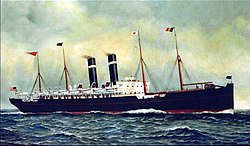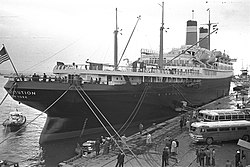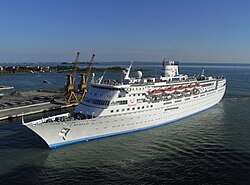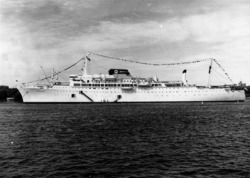| Name | Entered Service | Line Built/Rebuilt For | Shipyard | Designer | Status | Notes |
|---|
 | SS Morro Castle | 1900 | Ward Line | William Cramp & Sons, Philadelphia [10] | | Scrapped 1926 | Laid down for Plant Line in 1899 |
 | SS Kroonland | 1902 | Red Star Line | William Cramp & Sons, Philadelphia | | Scrapped 1927 | |
 | SS Finland | 1902 | Red Star Line | William Cramp & Sons, Philadelphia | | Scrapped 1928 | |
| SS Minnesota | 1905 | Great Northern Steamship Company | Eastern Shipbuilding Co., New London, Connecticut | | Scrapped 1923 | |
 | SS Dakota | 1905 | Great Northern Steamship Company | Eastern Shipbuilding Co., New London, Connecticut [11] | | Wrecked & sank 1907 | |
 | SS Saratoga | 1907 | Ward Line | William Cramp & Sons, Philadelphia | | Scrapped 1939 | |
| 1910s |
|---|
 | SS Great Northern | 1914 | Great Northern Pacific Steam Ship Company | William Cramp & Sons, Philadelphia | | Scrapped 1948 | |
 | SS Northern Pacific | 1915 | Great Northern Pacific Steam Ship Company | William Cramp & Sons, Philadelphia | | Burned and sank 1922 | |
 | SS Oriente | 1917 | Ward Line | William Cramp & Sons, Philadelphia | | Scrapped 1957 | Renamed SS Siboney for Ward Line after World War I |
 | SS Orizaba | 1917 | Ward Line | William Cramp & Sons, Philadelphia | | Scrapped 1963 | Commandeered by US Navy prior to launch for World War I, entered passenger service in 1920 |
| 1920s |
|---|
 | SS President Roosevelt | 1922 | United States Line | New York Shipbuilding of Camden, New Jersey | | Scrapped 1948 | - Originally built as a Harris-class attack transport towards the end of World War I, as Peninsula State, entered commercial service after her completion.
|
 | SS Coamo | 1925 | New York and Porto Rico Steamship Company | Newport News Shipbuilding and Drydock Company in Newport News, Virginia | | Torpedoed & Sank 1942 [12] | |
| SS Malolo | 1927 | Matson Line [13] | William Cramp & Sons, Philadelphia | Gibbs & Cox [2] | Scrapped 1977 | |
 | SS Iroquois | 1927 | Clyde Steamship Line | Newport News Shipbuilding and Drydock Company in Newport News, Virginia | | Scrapped 1981 [14] | |
 | SS Shawnee | July 1927 | Clyde Steamship Line | Newport News Shipbuilding and Drydock Company in Newport News, Virginia | | Burned 1949 | |
 | SS Yarmouth | September 1927 | Eastern Steamship Line | William Cramp & Sons, Philadelphia | Theodore E. Ferris [15] | Scrapped 1979 [16] | |
 | SS Evangeline | October 1927 | Eastern Steamship Line | William Cramp & Sons, Philadelphia | Theodore E. Ferris [15] | Burned & Sank 1965 | |
 | SS California | 1928 | Panama Pacific Lines | Newport News Shipbuilding and Drydock Company in Newport News, Virginia | | Scrapped 1964 | |
 | SS Virginia | 1928 | Panama Pacific Lines | Newport News Shipbuilding and Drydock Company in Newport News, Virginia | | Scrapped 1964 | |
 | SS Pennsylvania | 1929 | Panama Pacific Lines | Newport News Shipbuilding and Drydock Company in Newport News, Virginia | | Scrapped 1964 | |
| 1930s |
|---|
 | SS Morro Castle | 1930 | Ward Line | Newport News Shipbuilding and Drydock Company in Newport News, Virginia | Theodore E. Ferris [2] | Burned 1934 | |
 | SS Oriente | 1930 | Ward Line | Newport News Shipbuilding and Drydock Company in Newport News, Virginia | Theodore E. Ferris [2] | Scrapped 1957 | |
 | SS President Hoover | 1930 | Dollar Steamship Lines | Newport News Shipbuilding and Drydock Company in Newport News, Virginia | | Wrecked in storm 1937 | |
| SS Borinquen | 1931 | New York and Porto Rico Steamship Company | Fore River Shipyard, Bethlehem Shipbuilding Corporation, Quincy, Massachusetts [18] | Theodore E. Ferris | Wrecked 1970 | |
 | SS President Coolidge | 1931 | Dollar Steamship Lines | Newport News Shipbuilding and Drydock Company in Newport News, Virginia | | Sunk by Mine 1942 | |
 | SS St John | 1932 | Eastern Steamship Line | Newport News Shipbuilding and Drydock Company in Newport News, Virginia | Theodore E. Ferris [15] | Scrapped 1959 | |
 | SS Mariposa | 1932 | Matson Line | Fore River Shipyard, Bethlehem Shipbuilding Corporation, Quincy, Massachusetts [19] | Gibbs & Cox | Scrapped 1974 | |
 | SS Monterey | 1932 | Matson Line | Fore River Shipyard, Bethlehem Shipbuilding Corporation, Quincy, Massachusetts [20] | Gibbs & Cox | Sank on way to Scrapyard 2000 | |
 | SS Acadia | 1932 | Eastern Steamship Line | Newport News Shipbuilding and Drydock Company in Newport News, Virginia | Theodore E. Ferris [15] | Sold 1955 | |
 | SS Manhattan | 1932 | United States Lines | New York Shipbuilding of Camden, New Jersey | | Scrapped 1965 | Originally ordered for the Transatlantic Steamship Company |
| SS Santa Rosa | 1932 | Grace Line | Federal Shipbuilding and Dry Dock Company Kearny, NJ | Gibbs & Cox | Scrapped 1989 | |
 | SS Santa Paula | 1933 | Grace Line | Federal Shipbuilding and Dry Dock Company Kearny, NJ | Gibbs & Cox | Scrapped 1971 | |
| SS Santa Lucia | 1933 | Grace Line | Federal Shipbuilding and Dry Dock Company Kearny, NJ | Gibbs & Cox | Torpedoed & Sank 1942 | |
 | SS Lurline | 1933 | Matson Line | Fore River Shipyard, Bethlehem Shipbuilding Corporation, Quincy, Massachusetts [19] | Gibbs & Cox | Scrapped 1987 | |
| SS Santa Elena | 1933 | Grace Line | Federal Shipbuilding and Dry Dock Company Kearny, NJ | Gibbs & Cox | Torpedoed & Sank 1943 [21] | |
 | SS Washington | 1933 | United States Lines | New York Shipbuilding of Camden, New Jersey | | Scrapped 1965 | Originally ordered for the Transatlantic Steamship Company |
| 1940s |
|---|
 | SS America | 1940 | United States Lines | Newport News Shipbuilding and Drydock Company in Newport News, Virginia [22] [23] | Gibbs & Cox | Wrecked in Canary Islands 1994 [22] [24] | |
 | SS La Guardia | 1944/1948 | American Export Lines | | | Scrapped in 2005 | Converted from USS General W. P. Richardson (AP-118), a troopship that served with the United States Navy in World War II |
| SS President Cleveland | 1947 | American President Lines | Bethlehem Shipbuilding Co, Alameda, California | | Scrapped in 1974 | Originally ordered by the Maritime Commission during World War II, as one of the Admiral-class Type P2-SE2-R1 transport ships, completed instead as passenger ship. |
 | SS President Wilson | 1948 | American President Lines | Bethlehem Shipbuilding Co, Alameda, California | | Scrapped in 1984 | Originally ordered by the Maritime Commission (MC hull 687) during World War II, as one of the Admiral W. S. Benson-class Type P2-SE2-R1 transport ships, completed instead as passenger ship. |
| 1950s |
|---|
 | SS Independence | February 1951 | American Export Lines | Fore River Shipyard, Bethlehem Shipbuilding Corporation, Quincy, Massachusetts [26] | Henry Dreyfuss [27] | Wrecked on way to scrap yard 2011 | |
 | SS Constitution | June 1951 | American Export Lines | Fore River Shipyard, Bethlehem Shipbuilding Corporation, Quincy, Massachusetts [26] | Henry Dreyfuss [27] | Sank while under tow to shipbreakers, 1997 | |
 | SS United States | 1952 | United States Lines | Newport News Shipbuilding and Drydock Company in Newport News, Virginia [28] | Gibbs & Cox [29] | Out of Service since 1969, Laid Up | |
 | SS Monterey | 1952/1955 | Matson Line | Bethlehem Shipbuilding Co, at Sparrow's Point, Maryland [19] | | Scrapped 2006 | Ordered by the U.S. Maritime Administration as cargo vessel SS Free State Mariner, completed 1952. [30] Converted to passenger ship by Matson Line in 1955. |
 | SS Mariposa | 1953/1955 | Matson Line | Fore River Shipyard, Bethlehem Shipbuilding Corporation, Quincy, Massachusetts | | Burned & Scrapped 1996 | Ordered by the U.S. Maritime Administration as cargo vessel SS Pine Tree Mariner, completed 1953. [30] Converted to passenger ship by Matson Line in 1955. |
 | SS Atlantic | 1953/1958 | American Export Lines | Sun Ship Building & Dry Dock Co., in Chester, Pennsylvania | | Scrapped 1996 | Built as “Break Bulk Cargo Ship” for the “US Maritime Commission” in 1953 as the Badger Mariner. Converted to passenger ship by American Export Line in 1958. |
 | SS Santa Rosa | June 1958 | Grace Line | Newport News Shipbuilding and Drydock Company in Newport News, Virginia | Gibbs & Cox | Scrapped 2012 | |
| SS Santa Paula | October 1958 | Grace Line | Newport News Shipbuilding and Drydock Company in Newport News, Virginia | Gibbs & Cox | Bombed as Hotel ship 1990, Scrapped 2002 | |
 | SS Brasil | September 1958 | Moore-McCormack Lines | Ingalls Shipyards, Pascagoula, Mississippi [4] | | Scrapped 2004 | |
 | SS Argentina | December 1958 | Moore-McCormack Lines | Ingalls Shipyards, Pascagoula, Mississippi [4] | | Scrapped 2005 | Last deep water passenger liner to be completed in the United States |
| 2000s |
|---|
 | Pride of America | 2005 | American Classic Voyages/NCL America | Ingalls Shipyards, Pascagoula, Mississippi & Lloyd Werft, Bremerhaven, Germany | | In Service | Ordered for American Classic Voyages [31] |








































